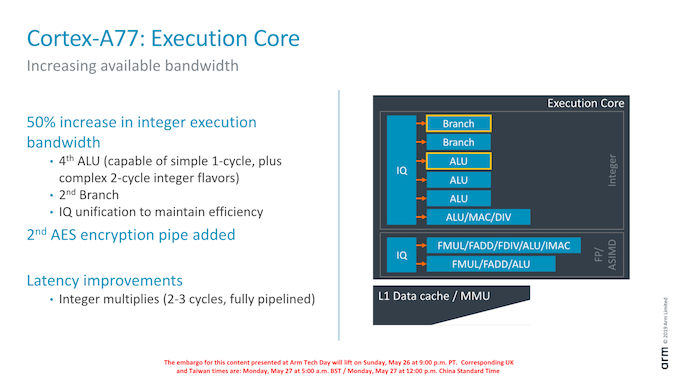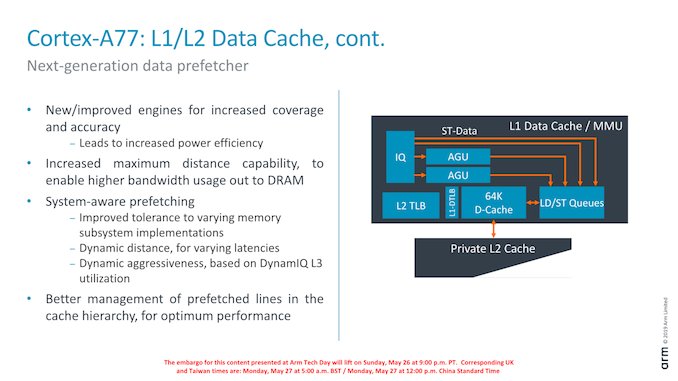Arm's New Cortex-A77 CPU Micro-architecture: Evolving Performance
by Andrei Frumusanu on May 27, 2019 12:01 AM ESTThe Cortex-A77 µarch: Added ALUs & Better Load/Stores
Having covered the front-end and middle-core, we move onto the back-end of the Cortex-A77 and investigate what kind of changes Arm has made to the execution units and data pipelines.
On the integer execution side of the core we’ve seen the addition of a second branch port, which goes along with the doubling of the branch-predictor bandwidth of the front-end.
We also see the addition on an additional integer ALU. This new unit goes half-way between a simple single-cycle ALU and the existing complex ALU pipeline: It naturally still has the ability of single-cycle ALU operations but also is able to support the more complex 2-cycle operations (Some shift combination instructions, logical instructions, move instructions, test/compare instructions). Arm says that the addition of this new pipeline saw a surprising amount of performance uplift: As the core gets wider, the back-end can become a bottleneck and this was a case of the execution units needing to grow along with the rest of the core.
A larger change in the execution core was the unification of the issue queues. Arm explains that this was done in order to maintain efficiency of the core with the added execution ports.
Finally, existing execution pipelines haven’t seen much changes. One latency improvement was the pipelining of the integer multiply unit on the complex ALU which allows it to achieve 2-3 cycle multiplications as opposed to 4.
Oddly enough, Arm didn’t make much mention of the floating-point / ASIMD pipelines for the Cortex-A77. Here it seems the A76’s “state-of-the-art” design was good enough for them to focus the efforts elsewhere on the core for this generation.
On the part of the load/store units, we still find two units, however Arm has added two additional dedicated store ports to the units, which in effect doubles the issue bandwidth. In effect this means the L/S units are 4-wide with 2 address generation µOps and 2 store data µOps.
The issue queues themselves again have been unified and Arm has increased the capacity by 25% in order to expose more memory-level parallelism.
Data prefetching is incredibly important in order to hide memory latency of a system: Shaving off cycles by avoiding to having to wait for data can be a big performance boost. I tried to cover the Cortex-A76’s new prefetchers and contrast it against other CPUs in the industry in our review of the Galaxy S10. What stood out for Arm is that the A76’s new prefetchers were outstandingly performant and were able to deal with some very complex patterns. In fact the A76 did far better than any other tested microarchitecture, which is quite a feat.
For the A77, Arm improved the prefetchers and added in even new additional prefetching engines to improve this even further. Arm is quite tight-lipped about the details here, but we’re promised increased pattern coverages and better prefetching accuracy. One such change is claimed to be “increased maximum distance”, which means the prefetchers will recognize repeated access patterns over larger virtual memory distances.
One new functional addition in the A77 is so called “system-aware prefetching”. Here Arm is trying to solve the issue of having to use a single IP in loads of different systems; some systems might have better or worse memory characteristics such as latency than others. In order to deal with this variance between memory subsystems, the new prefetchers will change the behaviour and aggressiveness based on how the current system is behaving.
A thought of mine would be that this could signify some interesting performance improvements under some DVFS conditions – where the prefetchers will alter their behaviour based on the current memory frequency.
Another aspect of this new system-awareness is more knowledge of the cache pressure of the DSU’s L3 cache. In case that other CPU cores would be highly active, the core’s prefetchers would see this and scale down its aggressiveness in order to possibly avoid thrashing the shared cache needlessly, increasing overall system performance.













108 Comments
View All Comments
peevee - Tuesday, May 28, 2019 - link
" ARM has finally leveled the playing field with Apple"With Apple's almost 3 y/o cores you mean. Because A13 is about to be released, even before SD865.
name99 - Tuesday, May 28, 2019 - link
“as I really don't expect major gains from the A13 as they've likely blown their wad“Based on what? The fact that you want it to be true?
jackthepumpkinking6sic6 - Thursday, May 30, 2019 - link
Clearly the one who wants something to be true is you. They just made a simple statement they felt was correct.Youre the one that flew in rude out of butthurt
Meteor2 - Monday, June 3, 2019 - link
I wouldn't bet on Apple not delivering big gains with A13. They have an incredible track record (because they can afford the best brains, and appear to be well managed). They'll run out of road eventually, but there's no sign that's happening yet.raptormissle - Monday, May 27, 2019 - link
> For the Cortex-A77, things should me a lot more straightforward to project as we won’t see major process node changes in the next generation 7nm SoCs.should be:
For the Cortex-A77, things should be a lot more straightforward to project as we won’t see major process node changes in the next generation 7nm SoCs.
0iron - Monday, May 27, 2019 - link
So A77 is a 'US origin technology' and will be affected by an export ban?ZolaIII - Monday, May 27, 2019 - link
Neither ARM nor Softbank are US origin, just plane stupid. Part of resurch labour & design teams are. The A76, A77 are from Ustin (Texas) based team.rahvin - Tuesday, May 28, 2019 - link
Pretty much any microprocessor you can think of is going to contain US origin technology. ARM might technically be incorporated in the UK but it's got US origin tech littering both it's architecture and it's individual designs.Meteor2 - Monday, June 3, 2019 - link
I'd like to see evidence of that; ARM is international now but for their first twenty-odd years they were wholly based in the UK.wilsonkf - Monday, May 27, 2019 - link
Most probably, but maybe also too late. Design stage should be mostly completed.